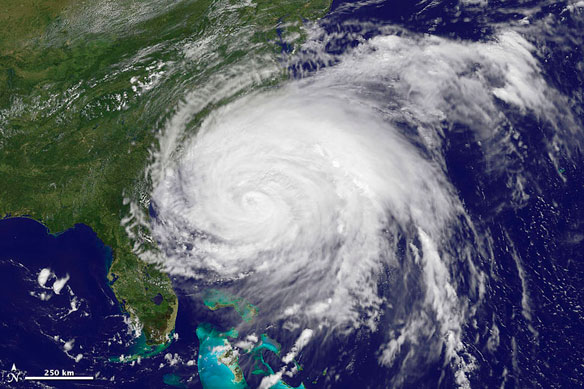
By NASA Earth Observatory
Irene, the first hurricane of the 2011 Atlantic season, was poised on August 26 to be the first to make landfall in the United States since 2008. More than 50 million people were estimated to lie within the path of the storm as it headed toward the major U.S. population centers of Norfolk, Washington, Baltimore, Philadelphia, New York, and Boston.
The coast of North Carolina and Virginia braced for a possible Category 3 storm, the strongest since 1996. Irene also appeared likely to become the first hurricane-force storm to make landfall in New England since 1991.
After developing into a tropical storm on August 20, Irene moved west and north to buffet Puerto Rico, Turks & Caicos, and he Bahamas. The storm brought extreme winds, storm surges, and flooding rains to each island before taking aim at the Carolina coast of the U.S.
At 11 a.m. Eastern Daylight Time (EDT) on August 26, 2011, the National Hurricane Center reported that Hurricane Irene was located at 30.7 degrees North latitude, 77.3 degrees West longitude, about 330 miles (530 kilometers) south-southwest of Cape Hatteras, North Carolina. The storm packed sustained winds of 105 miles (165 kilometers) per hour and was moving north at 14 miles (22 kilometers) per hour.
Forecasters noted at 11 a.m. on Friday that hurricane intensity was likely to remain stable for much of the day, with some potential (via warm Gulf Stream water) to intensify a bit. The storm should eventually lose some energy from southwesterly wind shear and the movement into cooler northern waters. Nonetheless, hurricane warnings and watches were posted from the South Carolina coast to Maine.
Extensive Erosion Likely along North Carolina Beaches during Irene: USGS
By U.S. Department of the Interior, U.S. Geological Survey
Sand washed inland by Hurricane Irene has the potential to cover Outer Banks roads, evacuation routes, coastal vegetation and lower levels of homes, according to a U.S. Geological Survey model for hurricane-induced coastal change.
Dune erosion and overwash, the landward movement of large volumes of sand, are forecasted for the North Carolina coastline with the projected landfall of the storm. The severity of the erosion and overwash depends on the strength of the storm and how direct a hit the coast takes.
“Our data and models show that large waves and high storm surge are likely to cause extensive erosion along the Outer Banks,” said USGS Oceanographer Hilary Stockdon.
The pre-storm assessment compares measurements of dune and berm elevations to potential hurricane-induced water levels, including surge and runup. Generated simulations found that extensive erosion was likely in most coastal environments given a direct landfall in that area.
In a direct hit, overwash is expected along 35 percent of the Outer Banks coast, typically in areas with lower dunes. In these areas, hurricane-induced waves and storm surge would transport large amounts of sand across coastal environments, depositing sand inland and causing significant changes to the landscape.
“Sand may also be removed from the nearshore wave system, making it unavailable to the beach for natural recovery after the storm,” said Stockdon.
The probability of the complete submersion of beach and dunes due to storm surge is low. Isolated barrier island breaching may be seen in very low-lying and narrow locations. These are typically areas that have been breached in the past.
Irene is the first hurricane of the 2011 Atlantic hurricane season. It is expected to track over the North Carolina coast Saturday.









